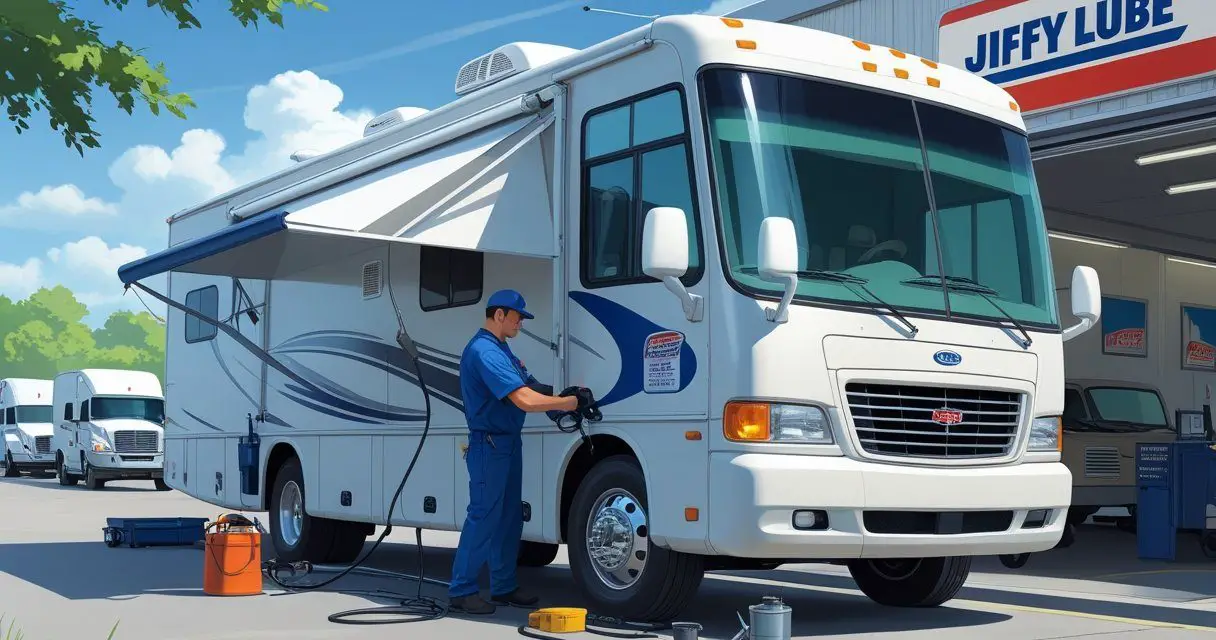Would you like to save this article?
If you own an RV, you know oil changes are not as simple as pulling into the nearest quick lube shop. The size of your motorhome and the type of engine it has often determine where you can go for service.
Some Jiffy Lube locations can handle RV oil changes, but not every shop has the space, equipment, or staff trained for larger vehicles.
You’ll need to call ahead to confirm if your local Jiffy Lube can take your RV. Even if a location says yes, it’s smart to ask about bay height, weight limits, and whether they’ve serviced RVs before.
This helps you avoid wasted trips or damage from tight maneuvering.
If Jiffy Lube isn’t an option, you still have plenty of choices. Truck service centers, RV dealerships, and even mobile oil change services specialize in handling larger vehicles.
Key Takeaways
- Some quick lube shops may service RVs, but not all can handle the size
- Specialized locations often provide safer and more reliable RV oil changes
- Cost, oil type, and service frequency depend on your RV’s engine and usage
Can Jiffy Lube Change Oil on an RV?
Jiffy Lube can sometimes handle RV oil changes, but it depends on the location, the space available, and the size of your motorhome. Not every service center is equipped for large vehicles, so you need to confirm details before you drive in.
Jiffy Lube RV Service Availability
Some Jiffy Lube locations do provide oil changes for RVs, especially for smaller Class B or Class C motorhomes. These shops can often treat an RV like a larger van or truck, making the process straightforward.
However, service availability is not consistent across all franchises. Each location is independently operated, so policies and capabilities vary.
You should always call ahead and ask if the shop accepts RVs. Provide details about your motorhome, such as class type, length, and engine type (gas or diesel).
If your RV uses a diesel engine, fewer Jiffy Lube centers may be able to service it. Diesel engines often require specialized filters and larger oil capacities, which not every location stocks.
Location and Facility Requirements
The ability of a Jiffy Lube to perform an RV oil change depends on its physical setup. Many shops are designed for passenger cars and light trucks, which means they may not have the clearance or equipment for taller or heavier RVs.
Bay door height is one of the most common limiting factors. If your RV is taller than the shop’s entry clearance, it simply won’t fit.
Some locations may also lack the proper lifts or pits to handle the extra weight. Parking and maneuvering space also matter.
Tight lots or narrow entrances can make it difficult to bring in a longer RV without risk of damage. Shops that are located near highways or in areas with more commercial truck traffic are more likely to have larger bays and more experience with oversized vehicles.
Vehicle Size Limitations
Your RV’s size class plays the biggest role in whether Jiffy Lube can service it.
- Class B campervans: Usually accepted, since they are close in size to large vans.
- Class C motorhomes: Sometimes accepted, depending on length and clearance.
- Class A motorhomes: Rarely accepted, as they are too tall and heavy for most locations.
Oil capacity is another factor. Large RV engines may require 6–8 quarts or more, while some Class A diesel engines can need over 15 quarts.
Not every Jiffy Lube keeps that amount in stock. If your RV exceeds the shop’s limits, you may need to visit a truck service center or a mobile RV oil change provider instead.
Alternatives to Jiffy Lube for RV Oil Changes
You have several reliable options for an RV oil change beyond chain service shops. Larger truck facilities, RV-focused dealerships, and even doing the work yourself can often provide better solutions depending on your needs, vehicle size, and budget.
Truck Service Centers
Truck service centers are often the most practical choice for an RV oil change. These shops are built to handle heavy-duty vehicles, so they have tall bay doors, high-capacity lifts, and staff experienced with large engines.
Unlike smaller auto shops, truck centers are familiar with diesel engines and higher oil capacities. Many RVs use 6–8 quarts of oil, and Class A motorhomes may need much more.
A truck shop already stocks the right filters and oil volumes. Calling ahead is important.
Some centers focus only on commercial fleets, while others welcome RV owners. Ask about their experience with motorhomes and confirm they can accommodate your RV’s length and height.
Pros:
- Designed for heavy vehicles
- Staff trained on diesel engines
- Ample space for maneuvering
Cons:
- May cost more than local garages
- Some locations only service fleets
RV Dealerships
RV dealerships often provide oil change services in addition to sales and repairs. These facilities are familiar with the specific engines used in motorhomes and usually follow manufacturer service guidelines.
One advantage is that dealerships can perform multiple maintenance tasks at once, such as checking your transmission fluid, coolant, or filters. This makes it easier to keep all your scheduled service in one place.
However, RV dealerships sometimes charge higher labor rates. Service quality also varies, so it’s worth checking reviews or asking other RV owners about their experiences.
Some dealerships may require an appointment weeks in advance, especially during peak travel seasons.
Best for: Owners who want brand-specific service and don’t mind paying a premium for convenience and expertise.
DIY Oil Changes
If you have the right tools and space, a DIY RV oil change can save time and money. Most RVs require a large drain pan, a socket set, and the correct oil filter.
You’ll also need to buy the proper oil type—synthetic or conventional—based on your owner’s manual. Changing the oil yourself takes about 30–45 minutes if you’re prepared.
Be sure to check local rules, as some campgrounds and neighborhoods don’t allow oil changes due to spill risks. Disposing of used oil responsibly is critical.
Many auto parts stores and service centers accept old oil for free recycling.
Tips for DIY success:
- Lay down absorbent pads to catch drips
- Pre-fill the new oil filter before installing
- Track mileage and date for your next change
DIY is best if you prefer control over the process and want to ensure only quality parts and fluids go into your RV.
What to Expect During an RV Oil Change
An RV oil change involves more than draining and replacing engine oil. You can also expect checks on filters, fluid levels, and other key systems that keep your motorhome running safely.
Service Process Overview
The process usually begins with draining the old engine oil from the RV. Because RVs hold more oil than cars, this step can take longer and requires larger equipment.
A technician then replaces the oil filter to ensure clean oil flows through the engine. After installing a new filter, the technician adds the correct type and amount of oil based on your RV’s engine—gas or diesel.
Diesel RVs often need more oil and heavier-grade products, which can affect both time and cost. Many service centers, including some Jiffy Lube locations, may ask about your RV’s size before the appointment.
This helps them prepare for clearance, bay space, and disposal needs. You should always confirm that the shop can handle your RV before driving in.
Inspection and Additional Maintenance
During an oil change, technicians often inspect other parts of your RV. They may check air filters, coolant, transmission fluid, and belts for wear.
These quick checks help spot issues before they become major repairs. Some shops also look at the chassis lubrication points, especially on larger Class A motorhomes.
Greasing these fittings keeps steering and suspension parts moving smoothly. If the oil analysis or inspection shows unusual wear, a technician may suggest early maintenance.
For example, a dirty air filter or low coolant level can reduce engine efficiency. Addressing these small issues during your oil change visit helps extend the life of your RV’s engine.
RV Oil Change Cost Factors
The cost of an RV oil change depends on where you take it, the type of engine you have, and the oil you choose. Service centers set different price points, and the size of your RV plays a major role in how much oil and labor are required.
Pricing at Service Centers
Service centers often charge more for RV oil changes than for cars because of the larger engines and higher oil capacity. For example, Camping World lists starting prices at about $169.99 for gas RVs and $329.99 for diesel RVs.
These prices usually include more than just oil and a filter. Many shops also check fluids, lubricate the chassis, and inspect wipers or belts.
That added labor contributes to the higher cost compared to a standard auto oil change. Location also matters.
A service center in a high-cost area may charge more than one in a smaller town. If you go to a chain like Jiffy Lube, you may find that only certain locations can handle RVs due to bay size or equipment limits.
Cost Differences: Gas vs Diesel RVs
Gas and diesel RVs have very different oil change needs. A gas-powered Class C or smaller motorhome may only need 6–8 quarts of oil, which keeps the price closer to what you’d expect for a large SUV or truck.
Diesel Class A motorhomes, on the other hand, can require 15–20 quarts or more. That increase in oil volume alone raises the price, but the filters are also larger and sometimes harder to access.
Because of these differences, you’ll usually see a $100–$150 gap between gas and diesel oil change costs. Diesel models also take more time to service, which adds labor charges.
If you own a diesel pusher, expect higher costs at nearly any service center.
Synthetic vs Conventional Oil Costs
The type of oil you choose has a direct impact on cost. Conventional oil is the least expensive, but it usually requires more frequent changes, often every 3,000–5,000 miles or once a year.
Full synthetic oil lasts much longer, sometimes up to 10,000–15,000 miles, and offers better protection for high-mileage or heavy-use engines. However, it can cost nearly double the price of conventional oil.
For RVs that sit for long periods, synthetic oil may be worth the investment since it resists breakdown better over time. If you drive shorter trips or only cover a few thousand miles each year, conventional oil may be more cost-effective despite the shorter interval.
Choosing the Right Engine Oil for Your RV
The oil you choose affects how well your RV engine performs, how long it lasts, and how often you need service. The right choice depends on oil type, your engine’s design, and the filter that keeps contaminants out.
Synthetic Oil Benefits
Synthetic oil provides stronger protection against heat and wear compared to conventional oil. RV engines often run for long hours and under heavy loads, so this added durability helps reduce breakdowns.
You may also notice easier cold starts and better flow in low temperatures. This is important if you travel in colder climates where thick oil can delay lubrication at startup.
Synthetic oil can also extend the time between oil changes. While you should always follow your RV manufacturer’s schedule, many synthetic oils resist breakdown longer, which may reduce how often you need service.
Common benefits include:
- Better high-temperature protection
- Improved cold-weather performance
- Longer oil life
If your RV is newer or you drive in demanding conditions, synthetic oil is often the more reliable choice.
Manufacturer Recommendations
Your RV’s manufacturer provides specific oil requirements for a reason. Engine design, tolerances, and performance needs vary, so using the recommended oil type and viscosity helps prevent damage.
For example, some engines require 5W-30 synthetic oil. Others may need 15W-40 conventional or synthetic blend.
These numbers reflect how the oil flows in different temperatures. This affects protection during startup and long drives.
Check your owner’s manual for:
- Viscosity grade (e.g., 10W-30, 5W-40)
- Oil type (conventional, synthetic blend, full synthetic)
- Service classification (API or ACEA ratings)
Following these guidelines helps you keep warranty coverage. Ignoring them can lead to higher wear and costly repairs.
Oil Filter Considerations
The oil filter is as important as the oil itself. It traps dirt, metal particles, and sludge so they do not circulate through your engine.
A clogged or poor-quality filter can reduce oil flow and cause engine wear. When changing your RV’s oil, always replace the filter at the same time.
Using a high-capacity filter designed for larger engines is especially important in motorhomes. These vehicles hold more oil and run longer between changes.
Look for filters that meet or exceed OEM specifications. Some filters are built with stronger materials and better seals, which helps them handle the higher pressures in RV engines.
If you use synthetic oil, pair it with a filter rated for extended intervals. This ensures your oil stays clean and effective for the full service life.
How Often Should You Change Oil in an RV?
The timing of an RV oil change depends on mileage, time since the last service, and how you use your motorhome. Engine type, driving conditions, and storage habits also play a role in how often you should replace your oil.
Mileage and Time Intervals
Most RV manufacturers recommend changing oil based on both miles driven and time passed. For gas engines, the interval is often every 3,000–5,000 miles.
Diesel engines may stretch to 5,000–10,000 miles, though some synthetic oils can last longer. Even if you don’t drive much, you should still change your oil at least once per year.
Oil breaks down over time due to oxidation and moisture, even when the engine sits idle. Following your owner’s manual and engine manufacturer’s instructions is the safest approach.
If your RV is under warranty, sticking to the recommended schedule is important. Missing an oil change could void coverage, leaving you responsible for repairs.
Special Considerations for RVs
RVs face different demands than passenger vehicles. Long periods of storage, heavy loads, and extended idling all affect oil life.
If you drive in hot climates, tow another vehicle, or climb steep grades, your oil may degrade faster. Older or high-mileage RVs may also need more frequent oil changes.
Worn engines produce more contaminants that reduce oil performance. Diesel pushers, for example, hold much larger oil volumes, which makes changes more expensive but still necessary.
When storing your RV for months at a time, change the oil before parking it. Used oil contains acids and contaminants that can damage internal parts during storage.
Fresh oil helps protect your engine until the next trip.
Signs Your RV Needs an Oil Change
Mileage and time are the main guides, but you can also look for warning signs.
Dark, gritty oil on the dipstick means the oil is dirty and should be replaced.
Other red flags include loud engine noise, reduced fuel efficiency, or an oil change reminder light on your dashboard.
Checking your oil level and condition regularly is a simple habit that helps you avoid missing these early signs.





